Disclosure: Some posts contain affiliate links, which earn us a commission if you make a purchase through them. Positive Fishing © participates in various affiliate networks including the Amazon Services LLC Associates Program.
Fly fishing is a unique style that can be intimidating because of the many aspects that complicate the sport. Thankfully, the sport has become more well-known today, and companies have made it far easier for anglers to enter the world of fly fishing, making it a more popular pastime.
Trout has always been the main quarry for fly fishermen. However, almost all fish can be caught using this method worldwide. This can encompass rivers, streams, lakes, open seas, and inshore flats.
One of the biggest knocks against fly fishing has always been the community. Many people in the sport haven’t always been welcoming, which has turned beginners away. Again, as it’s grown, it’s become more inviting and a place where male and female anglers of all ages, races, and skill levels can enjoy.
If you’re reading this article, hopefully, you want to join the sport but don’t know where to start; that’s okay. The following guide is packed with tips, gear recommendations, and best-buying links to get you started on the right track and provide you with all the necessary basic information to get out on the water.
In this article, I will cover the following:
- What is Fly Fishing?
- Where Can You Fly Fish?
- All the basic gear needed for Fly Fishing
- Fly Fishing Set-up
- How To Start Fly Fishing
- Best Places to Go Fly Fishing
- Tips for Reading Water and Fish Tendencies
- Fly Fishing Terms
What Is Fly Fishing?
Fly fishing gets its name from the bait that is used. On a fly fishing setup, anglers will use flies as their bait. Insects are common food for trout, and trout are the most common species targeted with a fly rod. As technology advances, more flies are being developed to imitate minnows, crayfish, frogs, and various other common types of prey. These flies allow anglers to target both salt and freshwater fish.
The fly rods and reels are much different than spin or baitcasting setups. Also, the casting methods are quite different! It requires much effort to get your bait to where you want it to go, but casting truly is an art.
The more you practice, the more smooth you will look. The weighted line allows for your fly to get where it needs to go and target the fish where they’re primarily living.
Where Can You Fly Fish?
The beauty of fly fishing is that you can do it almost anywhere where you can spin fish.
Ponds, lakes, rivers, streams, and even the ocean give you opportunities to land fish. The biggest challenge you’ll face is the room to make casts.
Since you’ll have to make backcasts, you’re a bit more limited in where you can fish. You must give yourself room on the side or behind you to make your casts. Heavily wooded shorelines can make life difficult since you won’t have much room to make long casts.
If you’re hoping to fish within 10 or 20 feet of you, you can get away with making a roll cast, but anything longer than that would require more room behind you.
Don’t let the “norms” of fishing dissuade you from trying to fly fish in areas. Bass, pike, and saltwater anglers can be very protective over their water. Don’t be overly intimidated, and see what you can find.
The beauty of fly fishing is that if you do it in an area that doesn’t get much fly fishing pressure, you’ll usually have quite a bit of success. Even if the fish are used to seeing soft plastics regularly, go and try fishing with flies – fish find them more natural and are more prone to feed on them. They’ll feast on them until they learn whether or not they like them.
Take your fly rod and the proper flies with you wherever you go. You’ll be shocked at how many fish you can land on the fly rod.
Basic Gear Needed for Fly Fishing
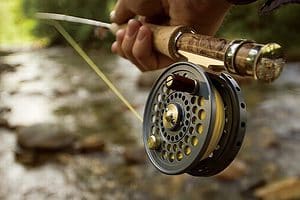
When you’re looking to enter the world of fly fishing, you’ll find thousands of options for rods, gear, line, and waders. Gear selection is the most overwhelming part of the fly fishing process. There are a few things that take priority in terms of selecting gear for fly fishing:
The first thing you need to consider is your budget. How much are you willing to spend on an entire fly-fishing setup? This will give you a great idea of what quality of gear you can afford and how much of it you can afford. If you feel new gear options are out of your price range, consider a more affordable second-hand purchase through eBay or Facebook groups.
The second thing you need to understand is the type of fishing you want to do. The best way to determine this is to look at the water around where you live. Understanding the water will give you all the information about the type of gear you need. Your local water is what you’re going to fish most.
Yes, you may be able to take a couple of fishing trips a year to different waters, but always make sure you plan accordingly for your local water, and it will hopefully be similar to the type of water you fish on your vacations.
Fly Fishing Rods
When selecting your first fly rod, you will want something a bit more versatile. It’s not always the smartest idea to purchase a very specific rod for your first. A more versatile rod will allow you to try your hand at various types of fishing!
Some great rod options for beginners are the Orvis Clearwater, Orvis Encounter, Snowbee Classic, Snowbee Diamond, Moonshine Vesper, and Sage Foundation.
Please check out my article on choosing the best fly rods for a more detailed review.
Versatile Rods
A versatile rod will be a five or 6-weight around 8’6” or 9 feet long. Also, do your best to purchase a moderate-fast action if possible. It’ll give you the power to land some of the more aggressive fish and also finesse your way around smaller mountain streams. These rods are usually considered “jack of all trades, master of none.”
If you want to target trout, bass, small steelhead, and salmon, a five or 6-weight will do the trick. Be careful not to get too bold with your fish selections, but any western United States trout fishing trip would require a five or 6-weight. Also, you can land bass if you don’t have any trout near you in your local waters.
If you purchase a decent five or 6-weight fly rod, it should last your entire fly fishing career. Fly fishing companies will often have lifetime warranties on their rods, so you don’t have to worry about fishing it too hard.
Big Fish Rods
If you want to land some big fish such as bass, pike, and the occasional salmon, you’ll need a seven or 8-weight rod. Rods at this weight will give you the opportunity to target these types of fish no matter where you are in the world. Most of these rods will be fast action, so keep this in mind!
A fast-action rod isn’t easy for beginners to fish. They require nearly perfect timing, and you’ll likely have to do quite a bit of practice on land before you’re able to make perfect casts in the water. They’re a blast to fish, but you’ll need to try to learn how to use them properly.
Small Fish Rods
If you’re spending time in the mountains in the Western United States and Europe going after wild trout, you’ll need to buy a smaller rod that allows you to finesse your way around gin clear mountain streams. A 3 or 4-weight will definitely do the trick. Make sure your rod is 7 to 8 feet in length. A shorter rod allows you to fish in heavily wooded areas that make it difficult to make back casts.
Most of these rods are going to be moderate or moderate-fast action. They’ll still give you the power to fight those potentially larger fish but also provide the necessary sensitivity to detect even the smallest of strikes. These rods are an absolute blast to fish with. You truly feel connected to the water and can feel all the action via the rod.
Similar to your big fish rods, they’re not easy to fish with for beginners. They take time to learn to get the right feel, but they will eventually provide you with hours of entertainment.
With so many manufacturers and types of rods, choosing the right rod for you can be difficult. A fly rod will last many years of fishing, so choose wisely.
Please read my in-depth article to learn more about fly rod action and weight.
Fly Fishing Reels
Choosing your fly reel isn’t nearly as complicated as choosing your fly rod. All you have to do once you purchase your fly rod is choose a reel that matches the weight of your fly rod. For example, if you purchased a 5-weight fly rod, then be sure to purchase a 5-weight reel.
The Orvis Battenkill, Orvis Clearwater, Moonshine Creede, and Snowbee Spectre are great reel options.
There are a few details, however, that are important when choosing your fly reel.
Arbor Size
The first thing you need to consider is your arbor size. Most anglers are going to want to purchase a large arbor reel. A large arbor reel will hold quite a bit of line to allow you to let a fish run, and you’d still have a chance to land it.
Drag
Most anglers are going to want a fully-sealed drag system. Yes, these are vital if you fish saltwater, but they also can be extremely useful if you target aggressive fish. Fully sealed drag systems will be more expensive, but they’re well worth the investment.
Lastly, make sure you invest in a saltwater-resistant reel. The fly reel you choose to use is important; don’t underestimate this crucial part of your gear.
Check out my article to understand how to use and select the best centrepin reels.
Fly Fishing Line
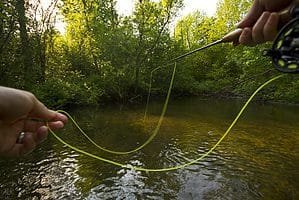
Like choosing your fly reel, your fly line choice doesn’t always have to be complicated. Your number one goal is to ensure the weight of your fly line is directly lined up with the weight of your rod and reel. You are allowed a little wiggle room in weight but don’t get too bold. If you have a 5-weight rod and 5-weight reel, you can use a 6-weight line.
Rio, Scientific Angler, and Snowbee all have wonderful options for a fly line.
Consider the following things before you make your fly-line purchase!
Fly Fishing Line Options
You’ll want to choose a floating line if you go after trout in streams and most rivers. A floating line will stay high on the surface, and you won’t have to worry about your line getting hung up on anything underwater. Your leader and tippet still have the chance to get tangled, but the line will stay high on the surface.
It’s perfect for fishing dry flies, nymphs, and streamers. If you need to get really deep, then a floating line isn’t your best option, but you should be perfectly fine for surface fishing and a bit below.
If you’re looking to fish lakes or in areas of rivers with deep moving water, you’ll want to use a sinking line. You can choose a full sinking line or just a sink tip line. A sink tip line will only put the last 15 feet of your line underwater. A full sink line will get you very deep, but then you risk getting trapped and hung up on several things underwater.
Salmon fishing, bass fishing, and even trout fishing can be done with a sinking line. You’ll notice that it’s a bit heavier when you cast, but that extra weight makes it easier to make longer casts!
Check out my article to help you choose the right trout fishing fly line.
Flies
The next thing that will take some extra consideration is the flies you’re going to use. Flies are extremely specific to the type of fish you’re targeting and where in the world you’re going after them.
There are three main types of flies that you’ll use in fly fishing: streamers, nymphs, and dry flies. These all serve specific purposes and can be used in almost any fishing situation. Just know where the fish are feeding, and you can make the correct choice.
Trout Flies
As you’ll quickly notice, there are hundreds of different patterns anglers can use to target trout. Depending on where the fish are feeding, you’ll know exactly where you should be fishing. Some of the best patterns for trout are going to be Pheasant Tails, Prince Nymphs, Elk Hair Caddis, Chubby Chernobyl, Stoneflies, and Woolly Buggers. These are all going to land fish during most times of the year.
Take the opportunity to study flies as you gain more experience in fishing. It can be extremely confusing, and you can easily forget the names of patterns and when they’re best fished. The more studying you do, the more familiar you’ll become and the more successful you’ll be.
Nymphs, dry flies, and streamers are all going to land fish! Dry flies are best used when the fish feed on the surface due to the insects’ hatching. Nymphs are great before and after hatches, and streamers can be used at any time of day.
Bass Flies
Bass is a really common fish to target on the fly rod. They’re gaining increasing popularity yearly due to their aggressive fights and easy accessibility. They live in almost every body of freshwater that you can find.
For Bass, I recommend using Poppers, Sex Dungeon Flies, Crayfish Patterns, and Clouser Minnow. Bass like to eat meat and larger prey. Any large, flashy fly will anger the bass and almost force them to strike whatever you’re throwing their way.
Salmon Flies
If you’re going after salmon, you have to be more specific with your fly choice. The salmon will want different types of flies depending on where you are in the world. Since you’ll be receiving strikes out of aggression, you want to ensure the salmon have plenty to look at.
Deceiver patterns, Bunny Leeches, Hex Nymphs, Spey Flies, and Egg Patterns will do the trick. Catching Salmon can take an extraordinary amount of patience to land, but once you learn their tendencies, you should have plenty of success.
Taking the right flies with you when fly fishing can get overwhelming. You can read my best flies buyers guide to ensure you have the right ones to catch more fish.
Waders
Are waders necessary in fly fishing? Yes and no. You’ll want waders if you’re going after trout in mountain streams. You’ll be limited if you can get yourself in the water. Angles and casting lanes are much easier to find if you can get out into the water closer to the fish!
You don’t need to wear waders if you only plan to fish off a boat.
You can purchase all-in-one waders with boots attached or waders without boots and purchase the boots separately. Choose waders based on where and how you fish and the water temperature. There are multiple choices on offer; to help you narrow down the options, check out my comprehensive guide on choosing the right waders, which will make the process far less confusing.
If you are looking for waders for women, check out my article here!
Fly Fishing Vest
I have left the fishing vest till the last item as it’s not crucial to have and use one as a beginner. These are expensive but help pack and carry all the items with you as you roam or wade around in the water. Having everything on you while fly fishing can be a huge convenience.
Yes, they make you look good on the water but get the basic equipment in place first, and once you’re ready to expand your gear, think about getting a fly fishing vest.
You can learn more by checking out my detailed review on the Orvis range of vests and how to choose the right fly fishing vest.
Accessories
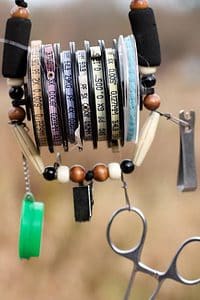
As a beginner, you will need various accessories, some more important than others.
Landing Net
Landing nets are required to gather your fish from the water. When starting out, it’s not necessary to buy an expensive net. Choose a telescopic landing net that is lightweight but strong enough to hold the fish when you catch it. Some nets fold up and can attach to your fishing vest via a magnetic holder.
For beginners, I suggest buying a telescopic landing net. Check out my review of the best ones available here!
Forceps
Sometimes called hemostats, these are for removing flies from the mouths of fish you catch.
Forceps come in various shapes and sizes. You will unlikely buy them regularly, so buy the best you can afford and take care of it!
For the best forceps options to buy and how to use them correctly, check out my article here!
Scissors
Small scissors are required to cut line, tippets, leaders, etc. They can be placed on the front of your fishing vest for easy use.
Again, fishing scissors don’t need to be bought yearly; buy a good pair and look after them.
Check out my article on the best scissor options and how to use them here!
Tippets And Leaders
Tippets and leaders go hand in hand. Tippets are a thinner piece of monofilament line connected to the end of the tapered leader, which attaches to the fly.
The leader is a single piece of fishing line that is designed to connect the thicker fly line to a fly. Over the course of a fishing trip, the thin leader will require replacing. Therefore, carrying a 5x tippet spool to repair the last small portion of your leader is necessary.
Pick one brand and stay with it. Tippets and leaders are not cheap items but are definitely worth investing in. It’s pointless hooking a fish and having it get away because of a bad choice of line or equally poor knot-tying!
For a more detailed review of tippets and leaders, take a look at my article here!
Fly Boxes
Over time, you will collect many flies of different types – nymphs, streamers, and dry flies. You will need several fly boxes to carry them in to keep them protected and easy to find.
As a beginner, you will only need a couple of smaller boxes; over time, choosing the right fly boxes and how you organize them will be more important.
Please read my articles on choosing the right fly box and my buyer’s guide to the best fly boxes here!
Fly Fishing Setup – Putting it all together
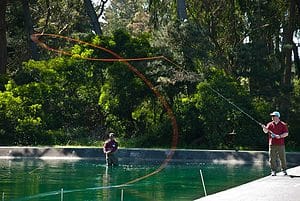
you go out on the water
At this point, we’ve discussed fly rods, reels, backing, fly line, leaders, tippets, flies, and more. This all leads to one of the most common questions from fly fishing beginners: How do you actually put it all together and get catching fish?
How to Start Fly Fishing
Once you have your gear purchased and set to go, you’re ready to hit the water. The first thing to do is make sure you learn how to cast. Casting can definitely be learned better on land. This way, you don’t have to worry about the water or any sort of vegetation getting in the way as you learn.
Once you feel as if you’re ready to hit the water, go to an area where you know you’ll land fish. Learning how to strip set takes some getting used to. Most anglers are used to setting the hook on a spin rod, and retraining your mind and muscles to suit fly fishing takes some time.
Even if you’re landing sunfish, you will learn how quick you need to be and the exact timing on when to set the hook. Do your best to land twenty or more fish before you start going after your ideal fish. This way, you won’t have to deal with missing hooking into the larger fish later, and it can save you some frustration.
Also, make sure you give yourself a chance to use a variety of flies. The more flies you get used to using, the better off you’ll be when the opportunities present themselves. Learn how the flies sink, float and move in the water.
Essentially, give yourself 5 to 10 trips to the water to experiment. Learn how to cast, how to present flies, how to strip set and how to land fish. All these take time, and you must practice patience in your learning process!
Best Places To Go Fly Fishing
Well, this all depends on the fish species you plan to target. So, let’s break this down into a few segments:
Fly Fishing for Freshwater Fish
Rivers and streams are the most common places to fly fish; freshwater lakes and saltwater are also popular. Fly fishing in moving water is probably the most exciting and also rewarding. It’s also the most complicated due to the changing body of water and depths. Casting and presenting your fly can be a challenging task.
Two superb examples of fantastic places to go freshwater fly fishing are Scotland for trout and salmon and trout fishing in Minnesota.
The rivers in Bolivia are superb for fly fishing. Catching Golden Dorado, pacu, and peacock bass on the fly is a joy to behold!
Fly fishing can be done all around the world!
Lakes are also very popular for fly fishing. Many lakes hold stocked brown and rainbow trout; lake fishing for bass, carp, and pike can be extremely rewarding. You will also be able to practice casting much easier due to the wider open spaces and fewer obstructions around you, such as overhead trees and river rocks.
For more details, check out my article on trout fishing vacations in the USA, which covers the best locations for fishing for a few days with family or friends.
Fly Fishing For Saltwater Fish
Finally, we come to the saltwater fly fishing. This is undoubtedly a major change in the scenery from rivers and lakes. The saltwater flats in Seychelles and Cuba are a true adventure that every fly fisherman must try sometime in their lifetime.
Fish such as permit, bonefish, tarpon, trevally, billfish, and wahoo can be caught fishing from the sand flats or on a skiff.
Tips for Reading Water and Fish Tendencies
When you first venture into moving water, you must pay attention to a few key things. First, watch the current and how fast it’s moving. If you’re a beginner, start with a slower-moving current. It won’t overwhelm you.
Secondly, cast near to structure. Structures are going to hold fish! Large rocks, tree laydowns, and cut banks will allow you to land fish. Fish don’t want to fight with the heavy current if they don’t absolutely have to do it. They’ll sit in slack water and then venture into the current for a couple of seconds to snatch food. Ideally, the food falls into the slower-moving water, and then they can make minimal effort to eat it.
Lastly, Always cast upstream. Casting upstream will put your fly in the best place to land fish. You’ll find that casting upstream isn’t always easy because it requires excessive mending and shifting of your fly, but if you only cast downstream, you won’t have nearly as many chances to land fish.
Fly Fishing Terms
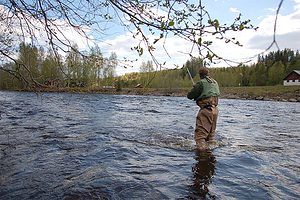
for the best fish locations.
The lingo in any outdoor sport is almost always confusing. There are even different dialects for some of these terms, depending on where you are in the country!
The following terms are a selection of the main ones used in fly fishing; you can find more in my article on fishing terms and words.
Mend
A “mend” is when you adjust your fly line in the water to achieve the most natural drift possible. They’re often just a flick of your wrist and a point with your rod upstream or downstream. This will accomplish everything you need!
Pocket Water
“Pocket water” is another term often used in fly fishing. Pocket water is the slow-moving water behind rocks or trees laying down in the water. Pockets are definitely where you’ll find the majority of fish.
Eddie
An “eddie” is a circular current in a river or stream. Look for eddies, as these areas hold fish waiting for an easy food source without having to move!
Back or False Cast
A “back or false cast” is casting your line backwards to make a much longer cast on the following attempt.
Match The Hatch
When an angler tries to match and use a dry fly to be identical to the insect species hatching at that specific time of the year.
Final Thoughts
Once you understand the basics, fly fishing can be one of the most enjoyable pastimes. I hope that this article gave you most of the tips and tricks you need to start your fly fishing journey.
The last key message is to get out there and start fishing! Practice makes perfect, and time spent on the water experiencing the pleasure of fly fishing will help you learn quickly!
Join the fly fishing community and experience the best sport in the world.
- Wading Belt Essentials: Ensuring Safer Fishing - January 9, 2024
- Fishing For Catfish (Top Tips, Bait, & Gear To Catch The Big 3) - October 20, 2022
- Fishing Line Strength Vs. Diameter Chart: Why Is It Important? - October 12, 2022

